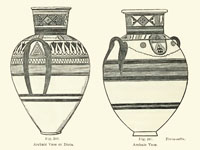Previous First Next
SALAMIS IN THE ISLAND OF CYPRUS.
BY ALEXANDER PALMA DI CESNOLÀ, F.S.A.,
page 115
of the British Museum. It belongs to the class just spoken of as tetinǽ; the mouth is closed, but a pipe opens from the base, and the vessel required to be inverted when it was to be filled, and then turned back upon its base. By these means the object could be feeding was forced to take the place of the breast; and the question is, how was that feeding effected 1 In this country and abroad, many antique vessels of terra-cotta have been discovered, which were formerly regarded as oil-cruses for the service of lamps; but they are now accepted as infants' feeding-bottles, upon which the title of tetinǽ has been bestowed. No doubt some of the long-spouted vessels were employed for libations. 1 For the names of the various forms of archaic Greek fictilia, the reader
filled with perfume for sprinkling the hands of distinguished visitors to the house of its owner on festive occasions. The  treatment of the curled hair of the figure, the concentric circles which constitute the decoration, and the very shape of the vessel, speak of the archaic times to which it must be referred. In respect of the hydrostatic arrangement of the interior, I believe this vessel is of the utmost rarity. I am indebted to Signor Vondiziani, a native of Larnaca, ex-Consul for Russia in Cyprus, for carefully restoring this vessel, which was broken to pieces when it was found. An archaic globular vase, perhaps an askos, decorated in a somewhat similar manner (fig. 265), has a star under the inscription of the handle, and is in like way enriched with an inscription in the Cypriotecharacter:— treatment of the curled hair of the figure, the concentric circles which constitute the decoration, and the very shape of the vessel, speak of the archaic times to which it must be referred. In respect of the hydrostatic arrangement of the interior, I believe this vessel is of the utmost rarity. I am indebted to Signor Vondiziani, a native of Larnaca, ex-Consul for Russia in Cyprus, for carefully restoring this vessel, which was broken to pieces when it was found. An archaic globular vase, perhaps an askos, decorated in a somewhat similar manner (fig. 265), has a star under the inscription of the handle, and is in like way enriched with an inscription in the Cypriotecharacter:—

which Professor Sayce reads:—ti. pi . ma . ta . ο . te . e . ta . that is—τα ηδεo δαμά πιθι.---"What you like, often drink." or—τα εθεο θαμά πΐθί. " What thou hast put (here) drink often." Dr. Deeckel 1. reads this:— τά[ς] Έτεοδάμα[ς]. πιθι.
may consult the concise and lucid " Appendix on the Forms and Uses of Greek and Etruscan Vases", in Mr. Dennis's new edition of the Cities and Cemeteries of Etruria, vol. i, pp. cv-exxvi, where a large number are figured and described.
 1. Zweiter Nachtrag, p. 160. 1. Zweiter Nachtrag, p. 160.
Another vessel, or amphora, of the Grǽco-Egyptian or Alexandrian style (fig. 266), is of very large dimensions, and beautifully adorned with geometrical patterns, filled in with chequered ornamentations, annulets, and spirals, as shewn in the illustration of enlarged details (fig. 268). The height of this vase is 41/2 feet. On the shoulder is the inscription, in Greek capitals, APΣINOHΣ ΦIΛAΔEΛΦΟΥ, evidently purporting to belong to Arsinoe Philadelphus, wife of the secondPtolemy. The accompanying figure (267) illustrates a vase, which, while in other respects resembling many others of the same class, both in the Lawrence - Cesnola and in other collections, has a shield-shaped addition evidently purporting to belong to Arsinoe Philadelphus, wife of the secondPtolemy. The accompanying figure (267) illustrates a vase, which, while in other respects resembling many others of the same class, both in the Lawrence - Cesnola and in other collections, has a shield-shaped addition
Previous First Next
|